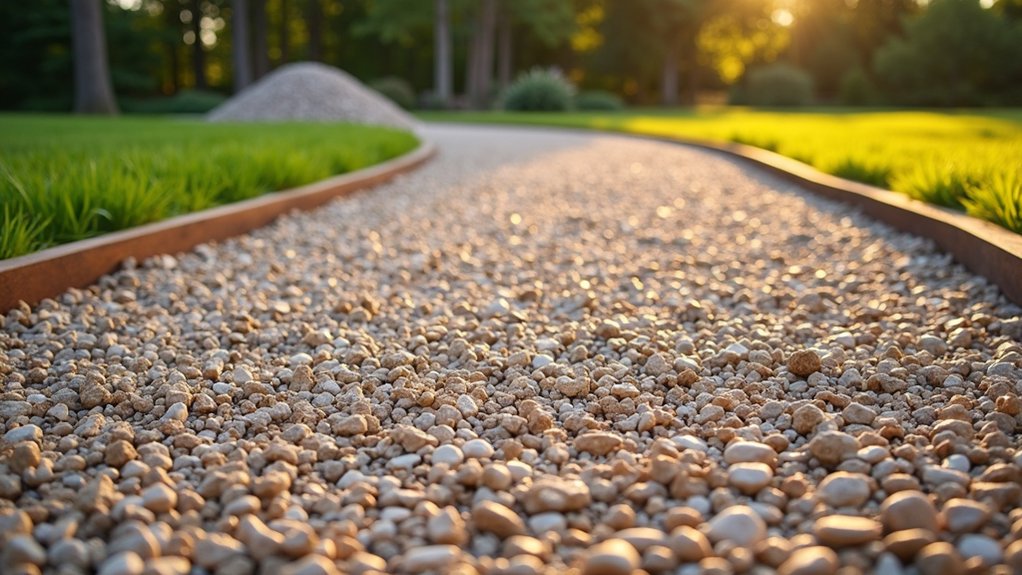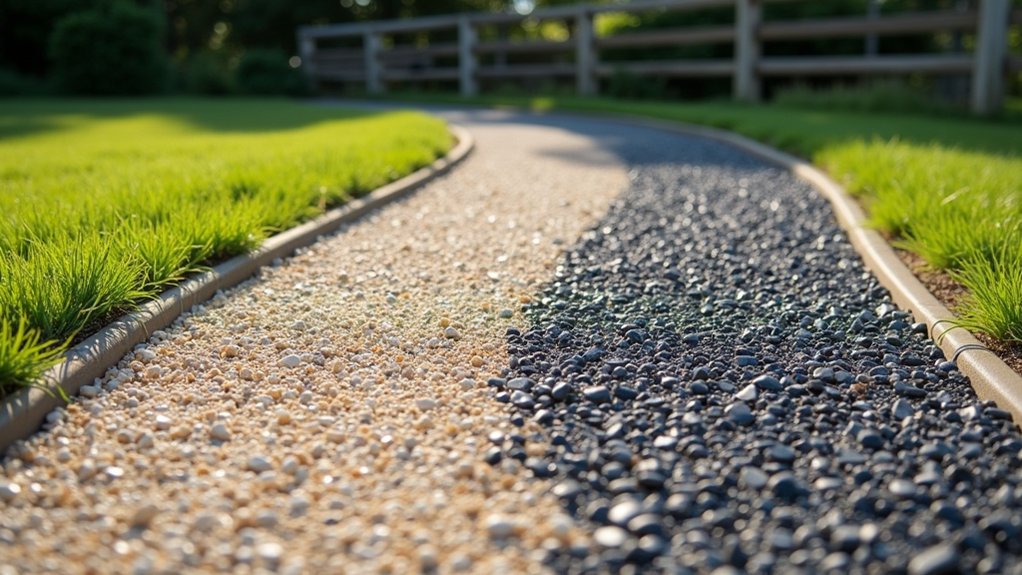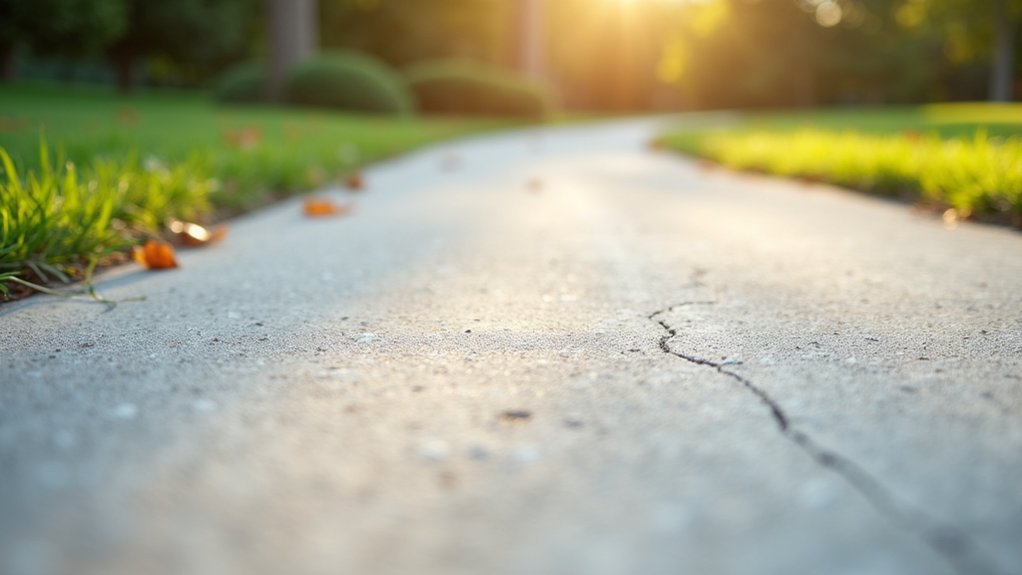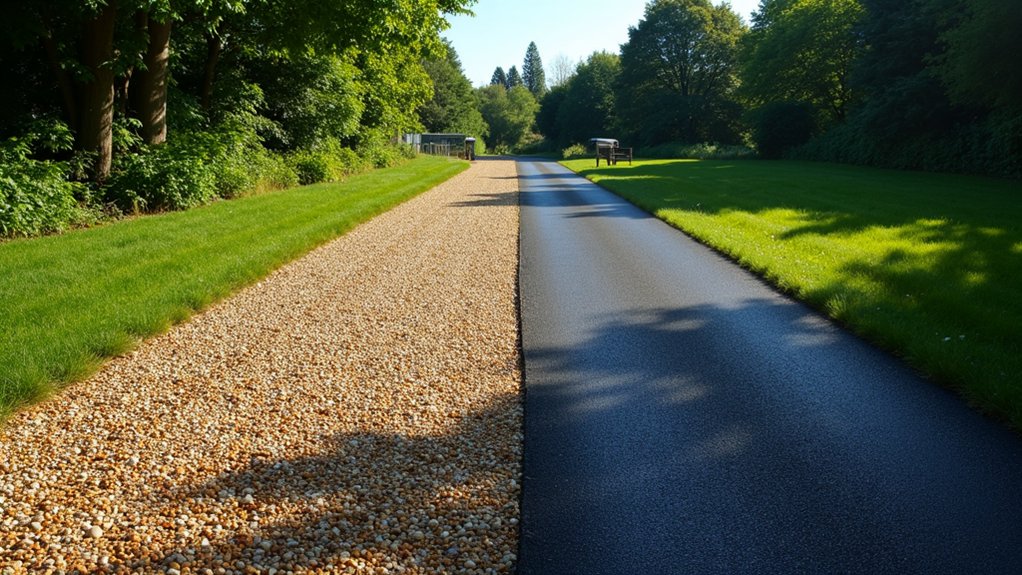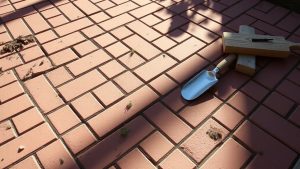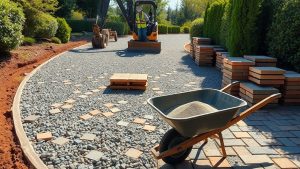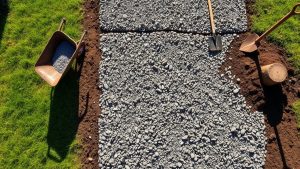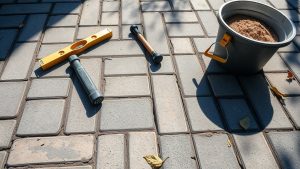To make your gravel driveway more stable and durable, begin with proper site preparation, which includes excavation and levelling. Ensure you have a compacted base layer to prevent soil settlement. Choose the right gravel size—aim for 20mm to 25mm for optimal support and drainage. Consider installing geogrids for added stability, and spread the gravel evenly. Implement effective drainage solutions to reduce erosion, and maintain the surface regularly. By following these strategies, you’ll enhance the longevity of your driveway and may discover additional ways to improve its durability.
Table of Contents
ToggleKey Takeaways
- Start with a well-compacted base layer to stop soil settling and increase the lifespan of your driveway.
- Use gravel grids to reduce gravel movement and maintain stability, especially under heavy vehicles.
- Regularly rake and replenish the gravel to keep the depth consistent, level the surface, and avoid ruts.
- Install drainage solutions, such as perforated pipes, to ensure proper water flow and reduce erosion.
- Use edge restraints like kerb stones to enhance structural integrity and prevent the stones from shifting.
Site Preparation and Excavation Techniques

For a stable gravel driveway, proper site preparation and excavation are essential.
Start by clearing the area of topsoil, grass, and debris to reveal the underlying soil. Use excavation techniques that allow you to control depth, aiming for between 50mm and 200mm, ensuring the base can support the weight of your vehicles. It’s important to use high quality decorative gravel for a beautiful finish that enhances the overall appearance.
Level the soil after removal with tools such as box graders or shovels, then compact the base using rollers or wacker plates for added stability. It’s crucial to consider slope and drainage; make sure the base slopes away from any buildings to promote effective water runoff.
If you’re dealing with soft ground, think about soil stabilisation methods, like using MOT Type 1 aggregate, to provide better support.
Importance of a Compacted Base Layer
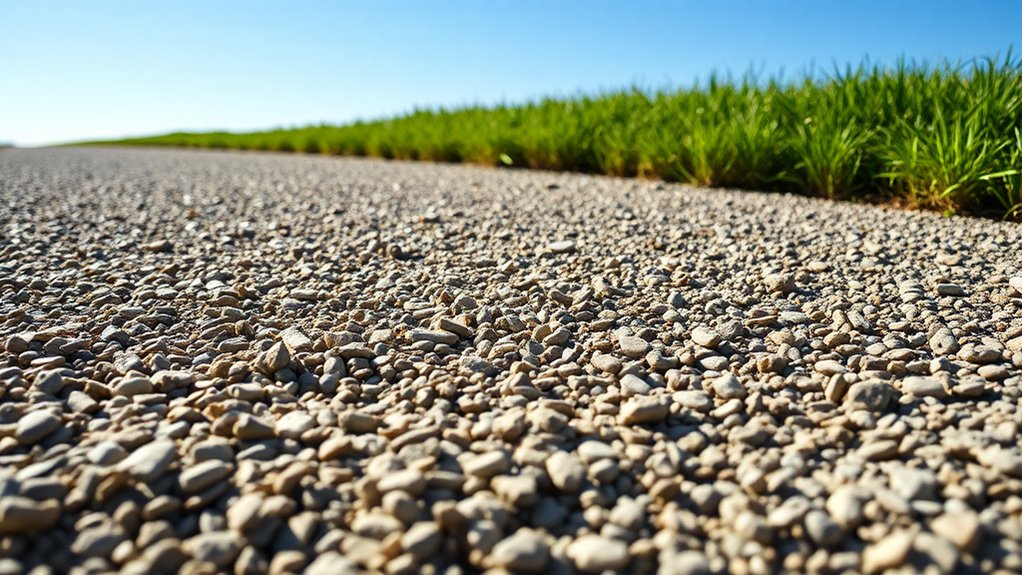
A compacted base layer is crucial for providing support, preventing soil settlement, and extending the life of your gravel driveway. Proper compaction ensures the base can handle heavy vehicles without deforming, which helps prevent early wear. Additionally, incorporating gravel grids can enhance stability by preventing gravel migration and rutting, further contributing to the durability of your driveway.
Enhanced Load Support
When constructing a gravel driveway, a compacted base layer is crucial for enhanced load support. A properly compacted base evenly distributes vehicle weight, reducing stress points and minimising the risk of ruts. Selecting the right materials, such as crushed rock and angular gravel, aids in effective interlocking, which boosts stability. Here’s a brief overview of essential factors:
| Factor | Importance | Recommended Material |
|---|---|---|
| Load Distribution | Ensures even weight across the surface | Angular gravel |
| Compaction Depth | 4-6 inches for optimal stability | Crushed rock |
| Material Interlocking | Minimises movement and shifting | Uniform grain size gravel |
| Weather Resistance | Provides a firm base against weather impacts | Geotextiles |
| Maintenance Frequency | Reduces frequency with high compaction | Durable materials |
Additionally, using road gravel as a foundational material can significantly enhance the durability and longevity of the driveway.
Prevents Soil Settling
When building a gravel driveway, it’s crucial to have a well-compacted base layer to prevent soil settling. Compacted soil reduces the chances of gravel shifting or forming ruts, especially under heavy use. A solid base helps to hold the gravel in place, allowing it to bear significant weight without deforming.
Proper compaction also enhances drainage, minimising water build-up and reducing erosion that could compromise your driveway’s stability. Regular maintenance and periodic compaction are key to preserving these advantages.
Choosing well-graded gravel for the base layer makes it easier to achieve optimal compaction, resulting in a more robust surface.
In short, a compacted base layer is essential for a long-lasting gravel driveway.
Improves Longevity and Stability
To ensure your gravel driveway stands the test of time, a well-compacted base layer is crucial. It provides the support needed to prevent ruts and deformation.
A thicker gravel layer offers added stability, especially in areas with loose or unstable soil. Here’s how to maximise longevity:
- Select high-quality gravel that promotes good drainage and structural strength.
- Employ proper installation techniques, such as compacting in layers to maintain consistent density and avoid sinking.
- Carry out regular maintenance, including re-grading and re-compacting, to prolong its life.
Selecting the Right Gravel for Stability
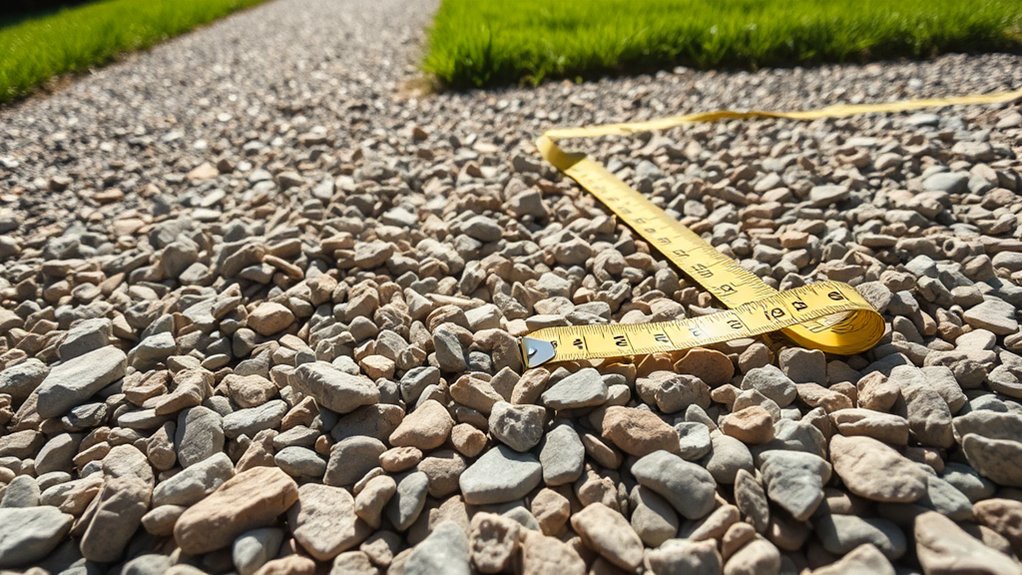
When choosing gravel for your driveway, the size and material are essential for stability.
Larger stones offer better drainage and support, while smaller particles aid in compaction, creating a solid surface.
For example, a mix of 20mm stones with finer grit can provide both strength and a smooth finish.
Gravel Size Importance
Choosing the right gravel size is crucial for the stability of your driveway. The type of gravel you select impacts both performance and drainage. Here are some key points to consider:
- ¾ inch to 1 inch: This size strikes a great balance between stability and effective drainage.
- 1 inch to 2.5 inches: Larger gravel works well in high-traffic areas, providing excellent support for heavy vehicles.
- Smaller than ¾ inch: While these sizes may be cheaper, they can cause drainage issues, leading to rutting and erosion over time.
Selecting the right gravel size will ensure your driveway remains functional and durable.
Material Composition Factors
Understanding the material composition of gravel is vital for a stable driveway. Choosing the right types of gravel greatly affects its stability. For example, crushed stone provides excellent structural integrity, while crushed granite is ideal for high-traffic areas due to its erosion resistance.
Consider using a mix like quarry process (also known as crusher run), which combines crushed stone with stone dust for a strong foundation. Incorporating geotextile fabric can help prevent soil and gravel from mixing, further enhancing stability.
Ensure your base layer is thick enough to bear vehicle weight and opt for angular gravel, which interlocks well. Proper drainage is crucial to avoid water accumulation and erosion, both of which contribute to the longevity of your driveway.
Installation of Geogrid for Support

To ensure your gravel driveway stays stable and durable, installing a geogrid is crucial. Geogrids offer structural support, prevent gravel movement, and improve drainage.
Here’s how to install one effectively:
- Prepare the Sub-Base: Make sure you have a firm, level, and well-draining sub-base for optimum performance.
- Select Geogrid Type: Choose the right type of geogrid for your needs—geocells are great for cellular confinement, while geo grids work well for free-draining surfaces.
- Connect and Lay: Use proper techniques to securely connect the geogrids, creating a stable layer beneath the gravel.
Proper Techniques for Gravel Placement

After installing a geogrid for support, the next step is gravel placement. First, remove any existing turf and debris to create a clean, level base. Spread gravel evenly to a minimum depth of 50mm, using shovels and rakes for an even distribution.
| Technique | Description |
|---|---|
| Gravel Layering | Spread gravel evenly across the area |
| Compaction Method | Lightly compact using a roller |
| Maintenance | Regularly rake to keep it level |
Use compaction methods that promote drainage without over-compacting the gravel. Remember to top up the gravel periodically to maintain depth and stability, ensuring your driveway remains durable and functional.
Drainage Solutions for Gravel Driveways
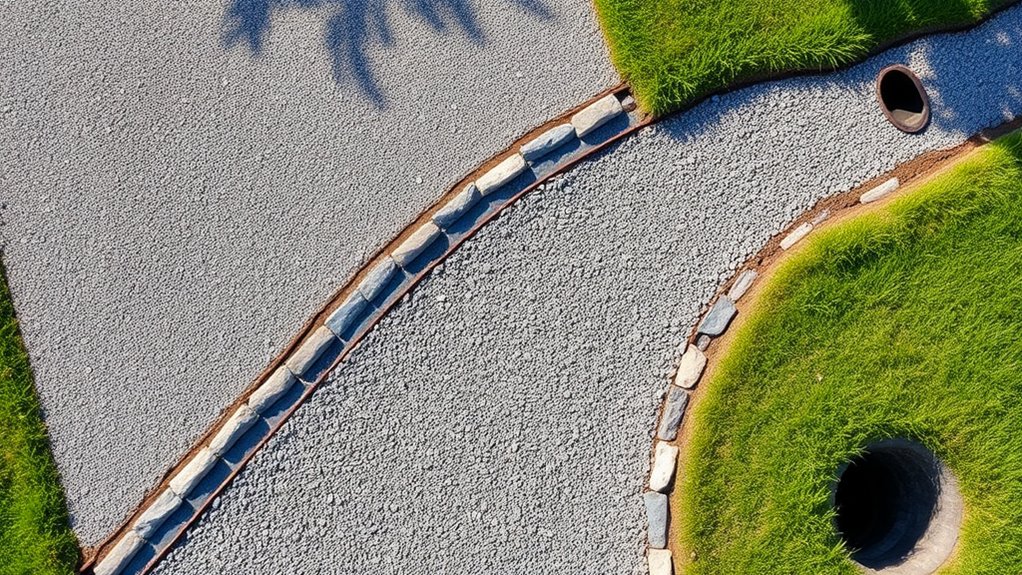
When installing a gravel driveway, it’s essential to address drainage to ensure its stability and longevity. Proper water management prevents erosion and stops water from pooling.
Here are three key drainage methods to consider:
- Perforated Pipe Installation: Position perforated pipes in shallow trenches along the sides of the driveway, ensuring a slight slope for optimal drainage.
- Channel Drains: Use channel drains to effectively collect surface water, especially in areas where the driveway slopes towards buildings.
- Porous Paver Systems: Opt for porous pavers that allow water to seep through into the gravel below, minimising surface runoff.
Implementing these drainage solutions will help keep your gravel driveway durable and functional.
Regular inspections and adjustments will also contribute to its longevity.
Maintenance Tips for Longevity
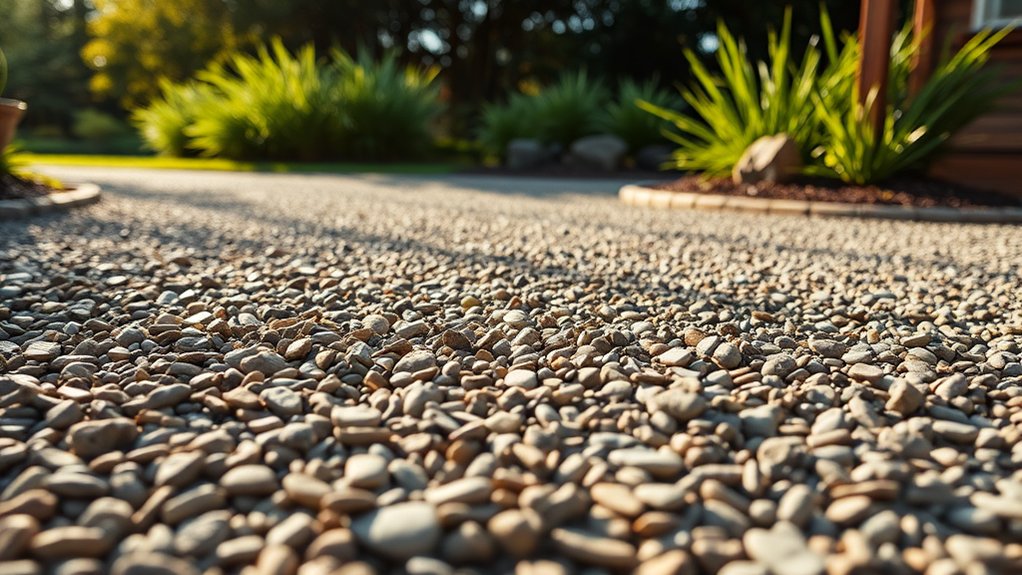
To prolong the life of your gravel driveway, follow these four essential maintenance tips. Regular upkeep is crucial; rake and level the surface monthly to prevent ruts. Address potholes promptly to avoid further damage. Controlling weeds is also important; consider installing a weed barrier fabric and manually removing any unwanted plants.
| Maintenance Task | Frequency |
|---|---|
| Raking and levelling | Monthly |
| Pothole repairs | As needed |
| Weed removal | Weekly |
| Seasonal inspections | Quarterly |
| Edging repair | Annually |
Enhancements for Additional Stability

Regular maintenance keeps your gravel driveway in good condition, but certain enhancements can significantly improve stability and longevity. Here are some straightforward suggestions:
- Install Gravel Stabilisation Grids: These honeycomb structures help maintain the integrity of the gravel, preventing stones from shifting and ensuring even weight distribution across the surface.
- Prepare a Solid Sub-Base: Excavate and compact gravel or sand to create a level foundation. This reduces settling and boosts long-term stability.
- Choose the Right Materials: Opt for angular or crushed gravel for the top layer. These types interlock better than rounded stones, providing greater stability.
Using Edge Restraints for Structural Integrity
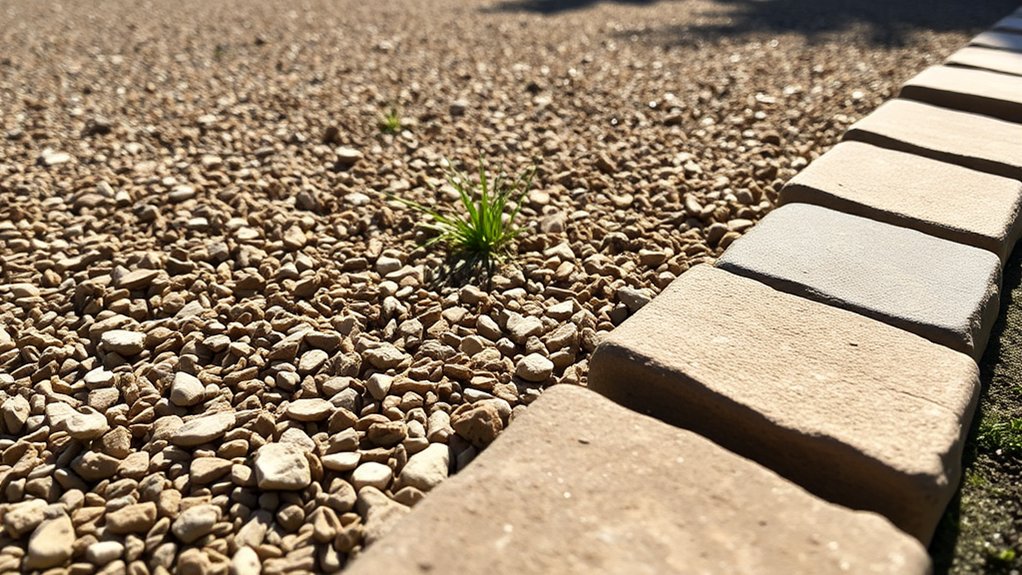
To improve the structural integrity of your gravel driveway, using edge restraints is essential. You can opt for various types, such as kerb blocks for robust lateral support, concrete for areas with heavy traffic, or flexible thermoplastic strips for curved edges.
Begin by marking the layout and preparing the base material to securely anchor the restraints. Place your chosen restraints flush with the gravel and use landscape spikes every 20 to 30 cm (8″–12″) to fix them in place.
Finally, check the level with a string line to ensure the restraint is even. This method prevents lateral movement, maintains shape, and boosts durability, ensuring your driveway remains stable and attractive for years to come.
Frequently Asked Questions
How Long Should I Wait Before Using My New Gravel Driveway?
You should wait at least 24 to 48 hours before using your new gravel driveway. This gives the gravel time to settle properly, which helps ensure stability and reduces the need for ongoing maintenance later on. For instance, just like you wouldn’t walk on fresh concrete until it’s set, waiting for your gravel to settle ensures a more durable surface for your vehicles.
Can I Use Recycled Materials for My Gravel Driveway?
You can absolutely use recycled materials for your gravel driveway. Mixing recycled asphalt with crushed concrete results in a sturdy, eco-friendly surface. Just ensure proper installation and compaction to prevent any future problems and maintain stability.
What Tools Do I Need for Gravel Driveway Installation?
For installing a gravel driveway, you’ll need some basic tools such as shovels and rakes, as well as different types of gravel. Familiarising yourself with various installation methods will improve your efficiency and help create a sturdy, long-lasting surface. For instance, using a compacting tool after laying the gravel ensures a level finish and prevents movement over time.
How Often Should I Inspect My Gravel Driveway?
You should check your gravel driveway at least two to four times a year. Regular inspections help spot issues like gravel settling early, which can prevent erosion and improve stability. This not only extends the life of your driveway but also saves you money on repairs.
What Is the Best Time of Year for Gravel Driveway Installation?
The ideal time for installing a gravel driveway is late spring or summer. During these seasons, the soil conditions are generally stable, which is crucial for effective compaction. This helps to prevent future problems such as erosion and instability in your driveway. For instance, trying to install gravel in wet or muddy conditions can lead to a poorly constructed surface that may require costly repairs later on.
Conclusion
To summarise, improving the stability and durability of your gravel driveway involves careful planning and execution. By following the suggested techniques—from site preparation to ongoing maintenance—you can create a robust surface that stands the test of time. Investing effort now can save you from costly repairs down the line. With the right materials and methods, your driveway can remain both functional and visually appealing for years to come.
Keen to enhance your driveway with the right gravel? Discover the best types and find out which one suits your Read more
Learn about the lifespan and durability of concrete driveways, and discover essential tips to ensure yours lasts for decades to Read more
Uncover the essential differences between gravel driveways and tarmac, and find out which option truly suits your needs best.

